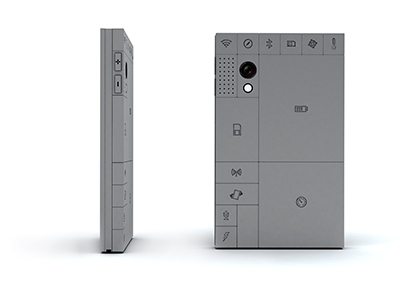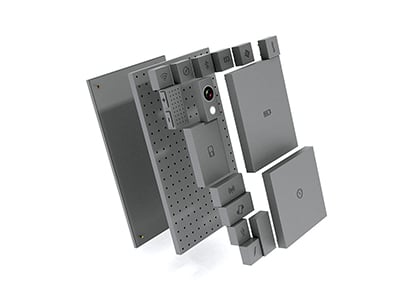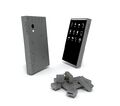JessieMisha (talk | contribs) No edit summary |
Sophivorus (talk | contribs) m (Text replacement - "{{JMC116inprogress[^}]*}}" to "{{JMC116 notice}}") |
||
| (17 intermediate revisions by 6 users not shown) | |||
| Line 1: | Line 1: | ||
{{ | {{JMC116 notice}} | ||
[[Image:Phonebloks front side.jpg|left|]] | [[Image:Phonebloks front side.jpg|left|]] | ||
Phonebloks is an innovative idea created by David Hakkens that uses modular technology in order to build a cellular device that will be longer lasting in the hopes of sustaining our technological dependency without producing excessive amounts of waste. Instead, the phone will be made of multiple parts that can be exchanged and substituted independently instead of as a whole device. Consumers will be able to customize their device and support different brands depending on what they are looking for in a phone<ref>http://web.archive.org/web/20131108081006/https://phonebloks.com/plan/</ref> | |||
== Purpose == | |||
[[Image:1280px-Phonebloks open.jpg|right|]] | |||
* Stop the Waste | |||
Electronic waste is a growing problem for a world in which the daily dependency and fascination with electronics is demanding and constant technological progress. When outdated or broken electronic products (such as phones, computers, VHS players, etc.) are thrown away, the waste is considered "e-waste". As more products are produced and distributed, more products are thrown away. | |||
* Help the Earth | |||
This waste contains heavy metals such as lead, mercury, cadmium, and chromium, which can all be toxic to our environment at high levels. PVC plastic, a component of many electronic devices, releases highly toxic dioxins and when e-waste is burned, brominated flame retardants generate brominated dioxins and furans.<ref>http://web.archive.org/web/20170629025952/http://www.hwma.net:80/hazardous-waste/electronicwaste</ref> | |||
In the US alone, more than 100 million computers are thrown away, with less than 20% being recycled properly. The EPA estimates as much as 60 million metric tons enter landfills every year.<ref>http://www.bostonelectronicwaste.com:80/go-green/what-is-ewaste</ref> Also, according to the Environmental Protection Agency, about 8% of mobile devices consumed are recycled.<ref>http://web.archive.org/web/20150721141747/http://www.epa.gov/epawaste/conserve/materials/ecycling/manage.htm</ref> By creating a mobile device that does not have to be fully replaced, waste is reduced. | |||
* Help Ourselves | |||
Often, electronic waste from the United States is dumped in other European and Asian countries. In China, particularly the western city Taizhou, the effects and dangers of e-waste can be noted. Around 2 billion tons of waste is dumped in Taizhou every year and around 60,000 citizens work with recycling the products, commonly without safety gear. A study done by Zhejiang University in Hangzhou, China, found that Reactive Oxygen Species (chemically reactive molecules that can strongly harm cells)including Interleaukin-8 (a protein that indicates an inflammatory response) and P53 (a protein from a tumor-suppressing gene that activates in response to DNA damage) violently reacted after being exposed to polluted air from the e-waste dump yard and caused damage to human lung cells used in the experiment. Still, research on the long term effects of electronic waste is relatively young and research is still being conducted. Until then, the amount of e-waste and lack of health protection against toxic chemicals created by e-waste poses a rapidly growing problem..<ref>http://www.popularmechanics.com/science/environment/waste/study-finds-e-waste-pollutants-could-harm-human-health</ref> | |||
Often, electronic waste from the United States is dumped in other European and Asian countries. In China, particularly the western city Taizhou, the effects and dangers of e-waste can be noted. Around 2 billion tons of waste is dumped in Taizhou every year and around 60,000 citizens work with recycling the products, commonly without safety gear. A study done by Zhejiang University in Hangzhou, China, found that Reactive Oxygen Species (chemically reactive molecules that can strongly harm cells)including Interleaukin-8 (a protein that indicates an inflammatory response) and P53 (a protein from a tumor-suppressing gene that activates in response to DNA damage) violently reacted after being exposed to polluted air from the e-waste dump yard and caused damage to human lung cells used in the experiment. Still, research on the long term effects of electronic waste is relatively young and research is still being conducted. Until then, the amount of e-waste and lack of health protection against toxic chemicals created by e-waste poses a rapidly growing problem. <ref>http://www.popularmechanics.com/science/environment/waste/study-finds-e-waste-pollutants-could-harm-human-health</ref> | |||
== Creator == | == Creator == | ||
Dave Hakkens is a 25 year old Dutch desiger who is credited as the concept creator of Phonebloks. <ref>http://www.dezeen.com/2013/10/19/phonebloks-mobile-phone-concept-by-dave-hakkens/</ref> When asked how the idea for Phonebloks came to him, he claims "It started when my camera broke. I took it apart to repair it and all the components were good except the motor — the LCD, the display, the battery, the flash, the gears, everything worked. I went online to order the spare part but I couldn’t find it. I had to throw the camera away, along with all the good components." <ref>http://www.smartplanet.com/blog/pure-genius/q-a-dave-hakkens-designer-of-phonebloks-on-reinventing-smartphone-design/10774</ref> After developing the idea for the Lego-like modular smartphone, Dave chose to upload his brainchild to the internet,[https://www.youtube.com/watch?v=BaPf4ZIbDVM in video format]. The video was designed to be an open platform | Dave Hakkens is a 25 year old Dutch desiger who is credited as the concept creator of Phonebloks.<ref>http://www.dezeen.com/2013/10/19/phonebloks-mobile-phone-concept-by-dave-hakkens/</ref> When asked how the idea for Phonebloks came to him, he claims "It started when my camera broke. I took it apart to repair it and all the components were good except the motor — the LCD, the display, the battery, the flash, the gears, everything worked. I went online to order the spare part but I couldn’t find it. I had to throw the camera away, along with all the good components."<ref>http://web.archive.org/web/20131105223804/http://www.smartplanet.com/blog/pure-genius/q-a-dave-hakkens-designer-of-phonebloks-on-reinventing-smartphone-design/10774</ref> After developing the idea for the Lego-like modular smartphone, Dave chose to upload his brainchild to the internet,[https://www.youtube.com/watch?v=BaPf4ZIbDVM in video format]. The video was designed to be an open platform "...companies will see they can make money and can start working together. The next step is to crowdsource — to set up a platform to actually start building."<ref>http://web.archive.org/web/20131105223804/http://www.smartplanet.com/blog/pure-genius/q-a-dave-hakkens-designer-of-phonebloks-on-reinventing-smartphone-design/10774</ref> This kind of collaboration is fostered at [http://www.designacademy.nl/ Design Academy Eindhoven] , where Dave Hakkens is a recent graduate. The school's website reads "Complex social, economical and cultural problems call for the creativity of people who dare to think outside the traditional frameworks. Our designers reflect on small-scale designs and they reflect on larger-scale themes, such as sustainability, well-being, healthcare, quality of life, public spaces and the contexts within."<ref>http://www.designacademy.nl/Research/StrategicCreativity/Latest/tabid/2889/articleType/ArticleView/articleId/2024/User-research-for-collaboration.aspx</ref> | ||
Dave Hakkens is also the creator of 'WindOil',a device that extracts oil from nuts and seed using power from a windmill. He also developed a machine that recycles plastic, called [http://www.preciousplastic.com/ 'Precious Plastic']. Dave states on his website that all of his projects come from a desire to "try to make the world better by making things". <ref>http://www.davehakkens.nl/about.html</ref> | Dave Hakkens is also the creator of 'WindOil',a device that extracts oil from nuts and seed using power from a windmill. He also developed a machine that recycles plastic, called [http://www.preciousplastic.com/ 'Precious Plastic']. Dave states on his website that all of his projects come from a desire to "try to make the world better by making things".<ref>http://web.archive.org/web/20140214044906/http://www.davehakkens.nl/about.html</ref> | ||
== Design == | == Design == | ||
<!-- Phoneblok Modular Concept. | |||
<!-- Phoneblok Modular Concept. --> | |||
<gallery caption="Phoneblok Modular Concept"> | <gallery caption="Phoneblok Modular Concept"> | ||
File:Phonebloks front side.jpg|Front/Side view | File:Phonebloks front side.jpg|Front/Side view | ||
File:1280px-Phonebloks open.jpg|Removable bloks | File:1280px-Phonebloks open.jpg|Removable bloks | ||
File:Phonebloks.jpg|Front/Back view | File:Phonebloks.jpg|Front/Back view | ||
File:Phonebloks change component.jpg| | File:Phonebloks change component.jpg| | ||
</gallery> | </gallery> | ||
Phonebloks’ modular design consists of a system that includes individual components for inexpensive and easy assembly, repair, flexible arrangement, and use. <ref>http://www.thefreedictionary.com/modular</ref> This modular system has been used to construct products like cars, houses, and computers. Phoneblock is the first publicly known concept for a modular smartphone. | Phonebloks’ modular design consists of a system that includes individual components for inexpensive and easy assembly, repair, flexible arrangement, and use.<ref>http://www.thefreedictionary.com/modular</ref> This modular system has been used to construct products like cars, houses, and computers. Phoneblock is the first publicly known concept for a modular smartphone. The phone was designed to reduce e-waste and to construct an open modular platform. It is comprised of small individual 'blocks' that have a specific purpose. This allows the user to customize the phone in any way they find suitable. Someone who enjoys photography may replace a large battery for a more complex camera. If the screen breaks, it can be easily replaced without discarding components that are not affected. The 'blocks' are connected to a base with pins which lock everything together into a solid phone.<ref>http://web.archive.org/web/20131204231312/https://phonebloks.com/questions/</ref> | ||
<!-- . | <!-- . --> | ||
<gallery caption="Other Modular Systems"> | <gallery caption="Other Modular Systems"> | ||
File:Acura NSX concept -- 2012 NYIAS.JPG|Automobiles | File:Acura NSX concept -- 2012 NYIAS.JPG|Automobiles | ||
| Line 52: | Line 49: | ||
== Future == | == Future == | ||
{{ | Phonebloks founder Dave Hakkens has moved forwards with the development of modular phones and met with companies interested in collaborating on the project. Dave decided to work with Motorola because their innovation team has been working in-house on a modular phone concept, Project Ara. This concept will create an open modular platform for independent and large companies to design and sell their bloks. An alpha release is tentatively set for winter of 2013. [http://motorola-blog.blogspot.com/2013/10/goodbye-sticky-hello-ara.html] | ||
{{Video|BaPf4ZIbDVM}} | |||
== References == | == References == | ||
<!-- This code is for placing the citation you included above. | <!-- This code is for placing the citation you included above. If you did not use the<ref>code, please delete this. --> | ||
<references/> | <references /> | ||
{{Page data}} | |||
Latest revision as of 13:17, 23 February 2024

Phonebloks is an innovative idea created by David Hakkens that uses modular technology in order to build a cellular device that will be longer lasting in the hopes of sustaining our technological dependency without producing excessive amounts of waste. Instead, the phone will be made of multiple parts that can be exchanged and substituted independently instead of as a whole device. Consumers will be able to customize their device and support different brands depending on what they are looking for in a phone[1]
Purpose[edit | edit source]

- Stop the Waste
Electronic waste is a growing problem for a world in which the daily dependency and fascination with electronics is demanding and constant technological progress. When outdated or broken electronic products (such as phones, computers, VHS players, etc.) are thrown away, the waste is considered "e-waste". As more products are produced and distributed, more products are thrown away.
- Help the Earth
This waste contains heavy metals such as lead, mercury, cadmium, and chromium, which can all be toxic to our environment at high levels. PVC plastic, a component of many electronic devices, releases highly toxic dioxins and when e-waste is burned, brominated flame retardants generate brominated dioxins and furans.[2]
In the US alone, more than 100 million computers are thrown away, with less than 20% being recycled properly. The EPA estimates as much as 60 million metric tons enter landfills every year.[3] Also, according to the Environmental Protection Agency, about 8% of mobile devices consumed are recycled.[4] By creating a mobile device that does not have to be fully replaced, waste is reduced.
- Help Ourselves
Often, electronic waste from the United States is dumped in other European and Asian countries. In China, particularly the western city Taizhou, the effects and dangers of e-waste can be noted. Around 2 billion tons of waste is dumped in Taizhou every year and around 60,000 citizens work with recycling the products, commonly without safety gear. A study done by Zhejiang University in Hangzhou, China, found that Reactive Oxygen Species (chemically reactive molecules that can strongly harm cells)including Interleaukin-8 (a protein that indicates an inflammatory response) and P53 (a protein from a tumor-suppressing gene that activates in response to DNA damage) violently reacted after being exposed to polluted air from the e-waste dump yard and caused damage to human lung cells used in the experiment. Still, research on the long term effects of electronic waste is relatively young and research is still being conducted. Until then, the amount of e-waste and lack of health protection against toxic chemicals created by e-waste poses a rapidly growing problem..[5]
Creator[edit | edit source]
Dave Hakkens is a 25 year old Dutch desiger who is credited as the concept creator of Phonebloks.[6] When asked how the idea for Phonebloks came to him, he claims "It started when my camera broke. I took it apart to repair it and all the components were good except the motor — the LCD, the display, the battery, the flash, the gears, everything worked. I went online to order the spare part but I couldn’t find it. I had to throw the camera away, along with all the good components."[7] After developing the idea for the Lego-like modular smartphone, Dave chose to upload his brainchild to the internet,in video format. The video was designed to be an open platform "...companies will see they can make money and can start working together. The next step is to crowdsource — to set up a platform to actually start building."[8] This kind of collaboration is fostered at Design Academy Eindhoven , where Dave Hakkens is a recent graduate. The school's website reads "Complex social, economical and cultural problems call for the creativity of people who dare to think outside the traditional frameworks. Our designers reflect on small-scale designs and they reflect on larger-scale themes, such as sustainability, well-being, healthcare, quality of life, public spaces and the contexts within."[9] Dave Hakkens is also the creator of 'WindOil',a device that extracts oil from nuts and seed using power from a windmill. He also developed a machine that recycles plastic, called 'Precious Plastic'. Dave states on his website that all of his projects come from a desire to "try to make the world better by making things".[10]
Design[edit | edit source]
- Phoneblok Modular Concept
-
Front/Side view
-
Removable bloks
-
Front/Back view
-
Phonebloks’ modular design consists of a system that includes individual components for inexpensive and easy assembly, repair, flexible arrangement, and use.[11] This modular system has been used to construct products like cars, houses, and computers. Phoneblock is the first publicly known concept for a modular smartphone. The phone was designed to reduce e-waste and to construct an open modular platform. It is comprised of small individual 'blocks' that have a specific purpose. This allows the user to customize the phone in any way they find suitable. Someone who enjoys photography may replace a large battery for a more complex camera. If the screen breaks, it can be easily replaced without discarding components that are not affected. The 'blocks' are connected to a base with pins which lock everything together into a solid phone.[12]
- Other Modular Systems
-
Automobiles
-
Modular Houses
-
Computers
Future[edit | edit source]
Phonebloks founder Dave Hakkens has moved forwards with the development of modular phones and met with companies interested in collaborating on the project. Dave decided to work with Motorola because their innovation team has been working in-house on a modular phone concept, Project Ara. This concept will create an open modular platform for independent and large companies to design and sell their bloks. An alpha release is tentatively set for winter of 2013. [1]
References[edit | edit source]
- ↑ http://web.archive.org/web/20131108081006/https://phonebloks.com/plan/
- ↑ http://web.archive.org/web/20170629025952/http://www.hwma.net:80/hazardous-waste/electronicwaste
- ↑ http://www.bostonelectronicwaste.com:80/go-green/what-is-ewaste
- ↑ http://web.archive.org/web/20150721141747/http://www.epa.gov/epawaste/conserve/materials/ecycling/manage.htm
- ↑ http://www.popularmechanics.com/science/environment/waste/study-finds-e-waste-pollutants-could-harm-human-health
- ↑ http://www.dezeen.com/2013/10/19/phonebloks-mobile-phone-concept-by-dave-hakkens/
- ↑ http://web.archive.org/web/20131105223804/http://www.smartplanet.com/blog/pure-genius/q-a-dave-hakkens-designer-of-phonebloks-on-reinventing-smartphone-design/10774
- ↑ http://web.archive.org/web/20131105223804/http://www.smartplanet.com/blog/pure-genius/q-a-dave-hakkens-designer-of-phonebloks-on-reinventing-smartphone-design/10774
- ↑ http://www.designacademy.nl/Research/StrategicCreativity/Latest/tabid/2889/articleType/ArticleView/articleId/2024/User-research-for-collaboration.aspx
- ↑ http://web.archive.org/web/20140214044906/http://www.davehakkens.nl/about.html
- ↑ http://www.thefreedictionary.com/modular
- ↑ http://web.archive.org/web/20131204231312/https://phonebloks.com/questions/







